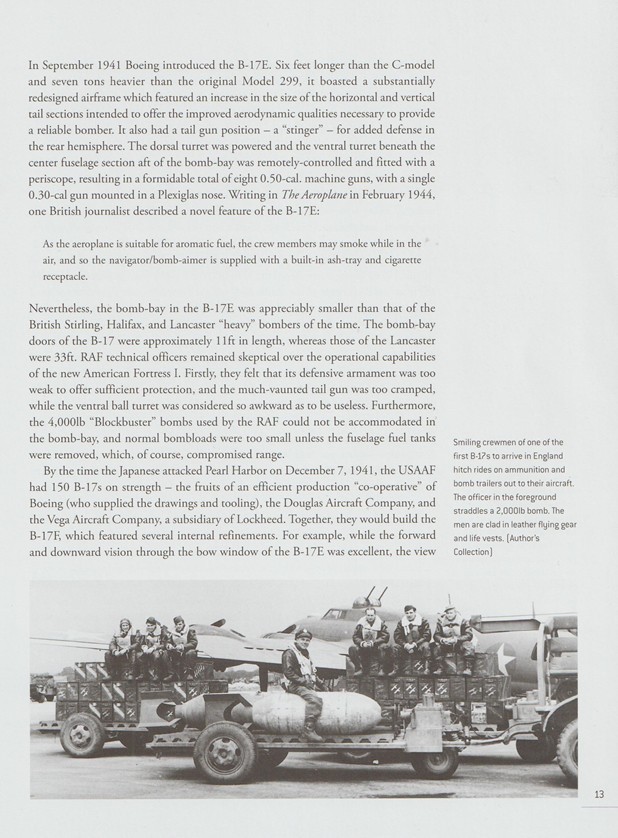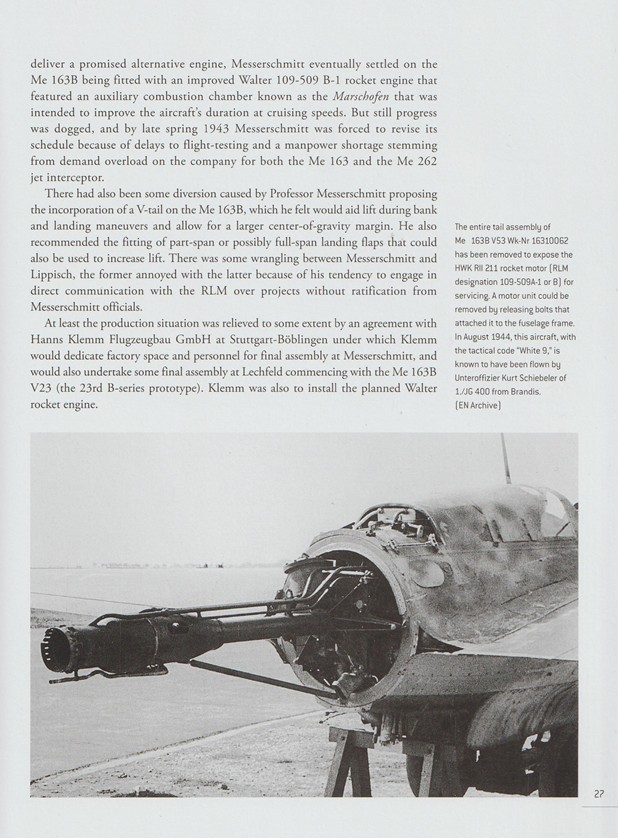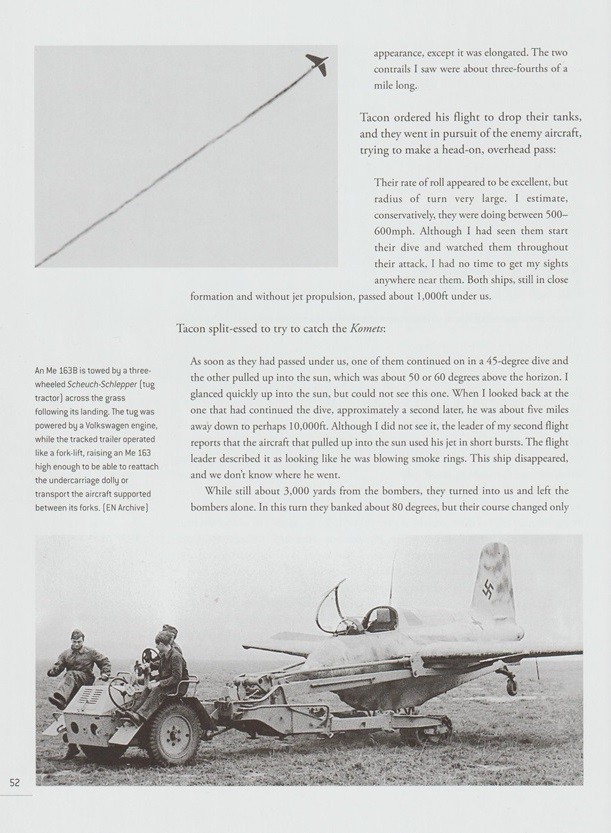HISTORY:
** In the summer of 1944, US Army Air Force (USAAF) crews flying over the Third Reich reported observing small, fast “batlike” aircraft passing close to their formations. The Luftwaffe's extraordinary Messerschmitt Me 163 interceptor – which used volatile rocket fuel to reach high altitudes at unprecedented speed – was making its devastating operational debut.
Luftwaffe historian Robert Forsyth draws on rare, first-hand accounts, archive photography, and newly commissioned artwork to chronicle the development and deployment of what was then the world’s fastest aircraft. Detailing the Me 163’s pivotal clashes with the B17s and B24s of the USAAF's Eighth Air Force and, from late 1944, the Lancasters of RAF Bomber Command, this fascinating volume documents the emergence of a new form of warfare – one that pitted sheer mass against cutting-edge aeronautical technology. **
** Quoted from rear of the book.
THE BOOK:
Osprey Publications has released Me 163 vs Allied Heavy Bombers, Northern Europe 1944-45 as Number 135 in the Duel series. It is an 80-page soft cover book. Included with the text are black and white and color photographs, color illustrations, detailed captions, and more. It has a 2024 copyright, a publication date of 25 April 2023, and the ISBN is 978-1-4728-6185-6
THE CONTENTS:
Introduction
Chronology
Design and Development
Technical Specifications
The Strategic Situation
The Combatants
Combat
Statistics and Analysis
Aftermath
Further Reading
Index
THE TEXT:
Author Robert Forsyth provides a well written and informative text which provides Messerschmitt Me 163 rocket-powered interreceptor aircraft in action against the allied heavy bombers in Europe during World War II. The text goes into great detail in all areas of the book as outlined on the contents page, please refer to the contents listing that I have provided for the areas that are covered. The design and development section starts with the American B-17 “Flying Fortress” and then moves on to the German Me 163 “Komet” rocket-powered interceptor. The technical specifications section also starts with the B-17 and discusses changes that were made to the bomber as well as its measurements, weight, engine types and size, airspeed, fuel capacity, crew served weapons, payload capability and operational ceiling. The Me 163 also has specifications provided such as changes made to the aircraft, its measurements, fuel capacity, weapon systems, speed, climb speed, amount of thrust, degree of wing sweepback and other such technical information. Information is provided on the areas targeted by the allies and the amount of damage and loss to the bombings and as a result the areas of where the Me 163 was to be deployed and put into use. Detailed information is provided on the training of the German Me 163 pilots from test flights to combat missions. There is also information provided on the training that the American bomber gunners participated in for defense of their aircraft. The combat section of the book provides the most text and details specific missions taken by both the allies and axis and actions taken by the Me 163 pilots and the crews of the allied bombers and the damage caused to the various aircraft by both allied and axis personnel. This chapter of the book contains over 20 personal accounts and quotes which author Robert Forsyth has also provided from both axis and allied pilots, crew members, engineers, and others such as journalists which helps provide excellent firsthand accounts of what took place during the various actions. The text in the book is nicely written, well detailed and informative. Robert Forsyth doesn’t use what I refer to as fluff writing where a large amount of non-essential extra text is provided just to help fill the pages. As I read through the text, I didn’t notice any spelling or grammatical errors. Grammar and spelling might not be an important factor to everyone; however, it is something that I take notice of and pass on my findings.
THE PHOTOGRAPHS:
A total of 49 black and white photographs and 2 color photographs are included in this volume. In addition to the main subjects of the book, the Me 163 interceptor aircraft and the B-17, B-24 and Lancaster heavy bombers, they contain subjects such as the pilots, groundcrews, military uniforms, aircraft weapons and ammunition, bombs, battle damage, allied and German manufacturing plants, nose art, towing vehicles and trailers and other such subjects. Some of the photographs that I am glad were included are detailed photographs of the Me 163’s under carriage dolly, landing skid, rocket engine and the 30mm cannon as well as the German three-wheeled Scheuch-Schlepper tug tractor. The photographs range from wide angle photographs to close-up detailed photographs. They are a combination of in-action photographs, photographs removed from motion pictures to photographs that have been staged for the photographer. The majority of the photographs are clear and easily viewable; however, a few have an out of focus look to them and some appear to be too dark, and others appear too light. This is typical for the discussed period of history and the quality of the photographs is no fault of the author and do not take anything away from the book. Author Robert Forsyth stuck to the title of the book and chose subject specific photographs and did not include photographs that strayed from the main subject. The majority, if not all, of the photographs will prove to be excellent reference material for the scale modeler due to the details they contain. The military historian, and the aviation enthusiast, interested in the use of the Messerschmitt Me 163 rocket-powered interreceptor aircraft in action against the allied heavy bombers in Europe during World War II, will also benefit from the excellent photographs.
THE ILLUSTRATIONS:
There are 12 color illustrations included in the volume by illustrators Gareth Hector and Jim Laurier. Most of the illustrations are accompanied by detailed captions. The illustrations are very well done, nicely detailed and are of:
- B-17G Armament Fields-Of -Fire
- A one-page illustration showing the fields of fire covered by each of the B-17’s .50 caliber Browning M2 machine guns.
- Me 163B Komet.
- A one-page illustrations showing post side, front and overhead views of the aircraft.
- Me 163B Komet.
- A one-page illustration showing the interior view of the Me 163B cockpit with 39 items of interest pointed out and identified in a detailed key.
- Sperry A-1 Top Turret.
- A one-page illustration showing the interior view of the top turret on a B-17 bomber with 20 items of interest pointed out and identified in a detailed key.
- The standard USAAF Combat Wing formation.
- A one-page illustration showing the standard bomber combat formation which would include 54 B-17s, sometimes mixed with B-24s, in three “boxes” of bombers in High, Lead and Low positions.
- Engaging the Enemy
- A one-page action illustration showing the pilot’s view from the cockpit of an Me 163B as he fires his weapons while engaging a B-17 bomber.
- Me 163B-1 Cannon Armament
- A one-page cut-away view illustration from the port side of a Me 163B-1 showing the Rheinmetall-Borsig MK 108 cannon, the 30mm ammunition, the port and starboard ammunition feed bins, and the spent shell ejection chute.
- B-17G Flying Fortress
- A one-page illustration showing the port side of the Cheyenne-built B-17G-25-BO 42-31713 “Snake Hips” B-17 bomber in August 1944.
- Me 163B Target Defense Tactics
- A one-page illustration showing a USAAF bomber formation that is targeting industrial plants in the Leizig area that have been detected by German Würzburg radar and as such Me 163 aircraft are being scrambled from airfield (JG 400) – Brandis to intercept the bombers.
- Me 163B-0 SG 500 Jägerfaust armament
- A one-page illustration showing the port side of an Me 163B-0 fitted with the SG 500 Jägerfaust armament arrangement. The illustration shows how the weapon was loaded, how it looked when loaded, and how the round exited upward from the aircraft upon firing.
- Me 163B vs British Lancaster Bomber, April 10, 1945
- A two-page action illustration showing the bottom view of a Me 163 piloted by Leutnant Friedrich Kelb of 2./JG 400 from the Brandis airfield flying under British Lancaster bomber B III ME 135 piloted by Sqn Ldr Campbell Haliburton Mussells. Kelb flew under the Lancaster and fired the SG 500 Jägerfaust which blasted away the rear turret, the starboard rudder of the Lancaster and killed one crew member and wounded two others. This was the only time the SG 500 Jägerfaust was used in combat.
- Lancaster B III
- A one-page illustration showing a starboard side view of British Lancaster B III ME 315 of No. 405 “Vancouver” Sqn as flown by Sqn Ldr Campbell Haliburton Mussells when attacked by an Me 163B armed with a 50mm SG 500 Jägerfaust vertically-firing volley weapon flown by Leutnant Friedrich Kelb of 2./JG 400.
THE CAPTIONS:
The captions are well written and explain the accompanying photographs in great detail eliminating any doubt as to what is shown. The captions go into very specific detail as to specific individual’s names, military ranks, type of uniforms being worn, dates, locations, military units, the type of aircraft shown, military markings and unit emblems, names of aircraft (nose art) weapons shown, specific items shown on the aircraft, the fate of specific pilots and their aircraft, what the individuals in the photographs are doing, they type of training that they are conducting, and other such pertinent information. As I read through the captions, I didn’t notice any spelling or grammatical errors. I was impressed by Robert Forsyth’s captions as they are very helpful to the reader due to their detailed content as opposed to other captions that I have seen in other publications that are brief and lacking in detail.
PROFILES:
There is one individual profiled in this volume and it is of:
Wolfgang Späte (8 September 1911 – 30 April 1997). A German Luftwaffe fighter ace. He was one of a select few pilots to have flown both the Me 163 and Me 262.
THE MAPS:
There is one color map included in this volume that shows:
The locations of several Me 163 airfields and industrial and hydrogenation plants in Germany. Poland, Austria, Belgium and the Netherlands. There is also a small key included that shows the maximum Me 163 combat radius from an airfield.
CONCLUSION:
As with the other Osprey Publishing titles I was impressed with this book. This is a very nice reference book that contains a well written informative text, many subject specific photographs and illustrations, well detailed captions and more, all detailing the Messerschmitt Me 163 rocket-powered interreceptor aircraft in action against the allied heavy bombers in Europe during World War II. As with the other Osprey Publishing titles, I would have no hesitation in recommending this book to others as it will be a welcome addition to one’s personal reference library.
Osprey Publishing also offers Me 163 vs Allied Heavy Bombers – Northern Europe 1944-45 as:
Ebook (Epub & Mobi) ISBN: 978-1-4728-6187-0
and
eBook (PDF) ISBN: 978-1-4728-6188-7
Osprey Publishing’s, Me 163 vs Allied Heavy Bombers – Northern Europe 1944-45, is also available as an electronic Kindle version through Amazon.com.
PRICE:
US $23.00/ UK £15.99/ CAN $31.00
This book was provided to me by Osprey Publishing. Please be sure to mention that you saw the book reviewed here on the KitMaker Network when you make your purchase. Thank you.
































